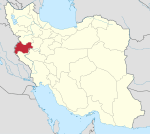Ganj Dareh
Coordinates: 34°27′N 48°07′E / 34.450°N 48.117°E
| تپه گنج دره | |
|
The early village site of Ganj Darreh near Kermanshah | |
 Location in Iran | |
| Location | Kermanshah Province, Iran |
|---|---|
| Region | Gamas-Ab Valley |
| Altitude | 1,400 m (4,593 ft)[1] |
| Type | mound settlement |
| History | |
| Founded | ca. 10,000 |
| Periods | Neolithic |
| Associated with | pastoralists |
| Site notes | |
| Excavation dates | 1967-1974[1] |

Ganj Dareh (Persian: تپه گنج دره; "Treasure Valley" in Persian,[2] or "Treasure Valley Hill" if tepe/tappeh (hill) is appended to the name) is a Neolithic settlement in the Iranian Kurdistan portion of Iran. It is located to the east of Kermanshah, in the central Zagros Mountains.[2]
First discovered in 1965, it was excavated by Canadian archaeologist, Philip Smith during the 1960s and 1970s, for four field seasons.[2][3]
The oldest settlement remains on the site date back to ca. 10,000 years ago,[4] and have yielded the earliest evidence for goat domestication in the world.[5][6][7] The only evidence for domesticated crops found at the site so far is the presence of two-row barley.[1]
The remains have been classified into five occupation levels, from A, at the top, to E.[8]
Genetics
Researchers sequenced the genome from the petrous bone of a 30-50 woman from Ganj Dareh, GD13a. mtDNA analysis shows that she belonged to Haplogroup X. Her DNA revealed that she had black hair, brown eyes, dark skin and was lactose intolerant.[1]
GD13 is genetically closest to the ancient Caucasus hunter-gatherers identified from human remains from Georgia (Satsurblia Cave and Kotias Klde), while also sharing genetic affinities with the people of the Yamna culture and the Afanasevo culture. She belonged to a population that was genetically distinct from the Neolithic Anatolian farmers. In terms of modern populations, she shows some genetic affinity with the Baloch people, Makrani caste and Brahui people. Her population did not contribute very much genetically to modern Europeans.[1]
References
- 1 2 3 4 5 Gallego-Llorente, M.; et al. (2016). "The genetics of an early Neolithic pastoralist from the Zagros, Iran". Scientific Reports. doi:10.1038/srep31326.
- 1 2 3 Smith, Philip E.L. Architectural Innovation and Experimentation at Ganj Dareh, Iran, World Archaeology, Vol. 21, No. 3 (February, 1990), pp. 323-335
- ↑ Smith, Philip E.L., Ganj Dareh Tepe, Paleorient, Vol. 2, Issue 2-1, pp.207-09 (1974)
- ↑ Zeder, Melinda A. & Hesse, Brian. The Initial Domestication of Goats (Capra hircus) in the Zagros Mountains 10,000 Years Ago, Science (journal) 287, 2254 (2000)
- ↑ What's Bred in the Bone, Discover (magazine), July 2000 ("After investigating bone collections from ancient sites across the Middle East, she found a dearth of adult male goat bones—and an abundance of female and young male remains—from a 10,000-year-old settlement called Ganj Dareh, in Iran's Zagros Mountains. This provides the earliest evidence of domesticated livestock, Zeder says.")
- ↑ Harris, David R. (ed.) The origins and spread of agriculture and pastoralism in Eurasia, pp. 208, 249-52 (UCL Press 1996) (Reprint ISBN 978-1-85728-538-3)
- ↑ Natural History Highlight: Old Goats In Transition, National Museum of Natural History (July 2000)
- ↑ Yelon, A., et al. Thermal Analysis of Early Neolithic Pottery From Tepe Ganj Dareh, Iran, in Materials issues in art and archaeology III (1992)
Bibliography
- Agelarakis A., The Palaeopathological Evidence, Indicators of Stress of the Shanidar Proto-Neolithic and the Ganj-Dareh Tepe Early Neolithic Human Skeletal Collections. Columbia University, 1989, Doctoral Dissertation, UMI, Bell & Howell Information Company, Michigan 48106.
- Robert J. Wenke: "Patterns in Prehistory: Humankind's first three million years" (1990)

